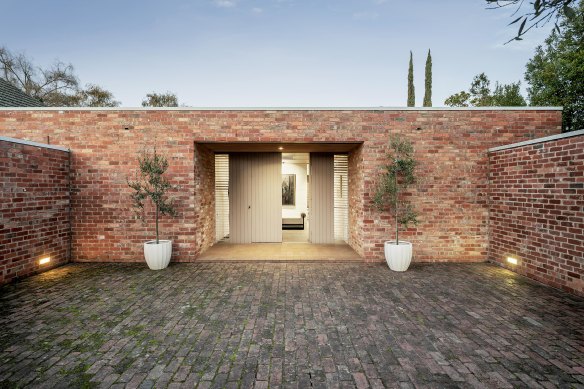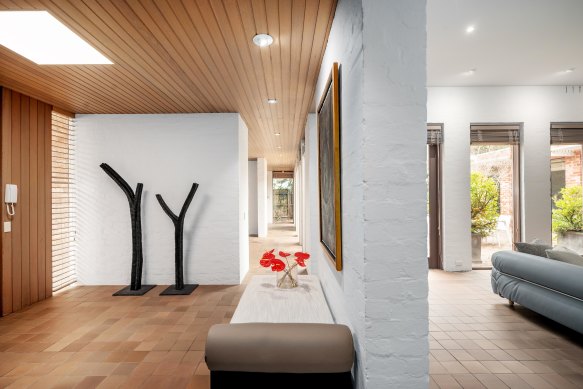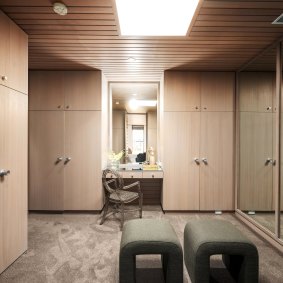The late architect Guilford Bell wasn’t the type to seek publicity. His homes, like the man himself, were reserved – allowing his architecture to do the speaking.
The recent sale of Hallows House, circa 1975, at 184 Kooyong Road, Toorak, not only attracted a crowd of about 100 people, it passed its reserve of $5.2 million, selling for $6.4 million at auction. Among the crowd were several leading architects, one of whom was handed the keys.

The entrance to Hallows House. designed by Guilford Bell.Credit: Jellis Craig
“I worked in Guildford’s office in the 1980s, transforming what was then used as an orchid room into a home office,” said buyer Ruth (who didn’t want her surname used), who was involved in changes to the original design of Hallows House. “I also worked on the drawings for the dressing area.
“It’s such a pure design, with most of the house still in original condition.”
Finding a Guilford Bell house is difficult, given the limited number of his bespoke homes remaining, with many having had makeovers.
While Hallows House had been “dressed” by a stylist, it exemplifies the interest in well-preserved period homes that – like art – come with provenance. All the joinery was intact, along with the symmetrical detailing Bell was renowned for. Unlike many kitchens today, which form part of living areas, this kitchen is discretely located behind the dining room wall – responding to a trend towards separate enclosed kitchens today. Bell’s tiled floors extend throughout the home, adding to his streamlined and pared-back aesthetic.

The interior entryway.Credit: Jellis Craig
Cardiologist Martin Hiscock, who has lived in a house by Roy Grounds (the architect of the National Gallery of Victoria) in Toorak and a heritage-listed Guilford Bell house in Brighton, understands the value of purchasing a significant 20th-century home. He still recalls the amount he spent restoring Grounds’ Hill Street house in Toorak – about $400,000 in the mid-1990s.
“I was fortunate that at least I could access original photos of that house that assisted me with the restoration,” said Hiscock.
A few years ago, he inspected a 1980s house in South Yarra designed by architect Graeme Gunn. It appeared original from the outside, but the interior had been made over.

The dressing area.Credit: Jellis Craig
“I would have had to spend at least $1 million to get it back to any semblance of what it was originally,” Hiscock said. “With heritage homes, many of the exteriors are protected, with the interiors being open to anything, sensitive or not.”
Carla Fetter, director of Jellis Craig’s Armadale office, which sold Hallows House, said interested buyers were local downsizers looking for single-level living, as well as younger families that weren’t familiar with Bell’s name.
“Most could appreciate how well-built the house is, being solid and timeless, with a floor plan that you’d see today,” said Fetter, who thought that a number of people attending the auction considered only slight cosmetic changes.
“You’re acquiring a slice of history as much as a great design,” said Mile Beardsley, a sales agent with Jellis Craig.
- Advice given in this article is general in nature and is not intended to influence readers’ decisions about investing or financial products. They should always seek their own professional advice that takes into account their own personal circumstances before making any financial decisions.
Expert tips on how to save, invest and make the most of your money delivered to your inbox every Sunday. Sign up for our Real Money newsletter.